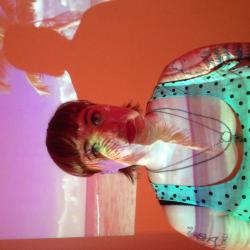The recent resumption of fin whale hunting has drawn attention onto Hvalfjörður, the fjord near Reykjavík where the whaling station is located. The fjord is not, however, only known for this industry, but also for its role in Iceland’s involvement in World War II. In a former community centre on the north shore of the fjord, the War & Peace Museum commemorates this chapter of Iceland’s history in a sort of cinematic time capsule.
Owner and curator Guðjón Sigumundsson (Gaui Litli) moved to Hvalfjörður in 2010 after the country’s economic collapse and began renting the building that now houses his museum. Having worked in the film industry for 35 years as a set dresser and props person, he was already an avid collector of historical items, but began collecting in earnest for the museum 13 years ago.

Photo by Art Bicnick
“This house was totally empty when I came, so I thought maybe I should collect stuff that is related to whaling because it’s the whale fjord,” says Gaui. “My grandmother was with me when we came and drove [around] the fjord. She was talking about the British occupation and she thought we had cheated the Danish when we got independence in 1944 during the war, because the Danish were [occupied by] Germany. Then I thought maybe I should tell that story.”
The story told in the museum is one that spans the arrival of British military forces in 1940 to the dissolution of the war in 1945, through a chronological maze-like journey of distinct scenarios. Upon arrival at the museum, one is recommended to start their visit in the far corner of the building and work their way back to the front through twists and turns leading to present day.
“We talk more about peace than war and we mix daily things in between the war items to get a more cozy relaxed feel,” says Gaui. “People that visit war museums all over the world say it’s a very nice place because you’re up close with the things that are on display. You can even touch the uniforms and stuff like that.”
A walk through time
Some of the museum’s exhibition displays scenes of a barbershop, a grocery store, a child’s collection of toys and a dance hall, however all of these are still within the framework and context of wartime. One can indeed get very personal with the display, even leafing through old soldiers’ journals, reading combat maps and sitting in the old furniture.

Photo by Art Bicnick
Gaui’s experience in set design has made it so that the details really stand out. A harmonium plays every ten minutes with a loop of old Icelandic songs he pre-recorded, an old army Jeep in the main hall starts its engine (in sound only) every fifteen minutes, and the main hall has a jukebox continuously playing old big-band standards. One can also listen to original recordings of radio communications through military headsets from the era.
Uncomfortable and questionable
However, the considerable amount of Nazi memorabilia and propaganda – despite German forces never arriving in Iceland – versus the negligible memorial to the Holocaust is slightly jarring. A prop of an emaciated corpse – a remnant of a Hollywood production, says Gaui – in a coffin with its face covered by a shroud lies beneath a small plaque noting the death toll of the genocide.

Photo by Art Bicnick
“I have been asking older Germans if it would be difficult for them to see all that and they say no,” says Gaui in regards to these artefacts. “The younger generation totally understand that we should talk about these things. Jewish visitors particularly react to that, because it is a very different representation from a lot of displays that they’ve seen.”
The importance of peace
The main messaging for peace exists on the exterior of the building, in the art that adorns the outside walls, and a statue named Hope for Peace that was gifted by a Russian artist with some connection to the military activity in Hvalfjörður. While Gaui’s own feelings about war and military presence in Iceland seem somewhat mixed, he does hope for peace.
“I’m just here to tell the story of the Second World War,” he says. “We should talk about these things and put it on display because people need to understand that peace is more important than war. No one is gaining of war. Just the guys that are selling bombs and guns and stuff.”
The War & Peace Museum is currently closed for the winter, but open for groups of five or more on demand. Visit warandpeace.is for more information.
Buy subscriptions, t-shirts and more from our shop right here!










